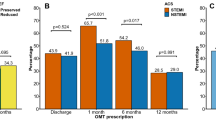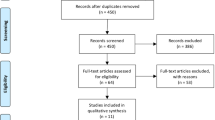Abstract
Background
Predictors of long-term mortality after discharge after acute myocardial infarction (AMI) are well characterized. However, these established risk factors are based on data almost exclusively derived from older studies without consistent use of revascularization therapy and adjunctive therapy with statins, platelet inhibitors, beta-blockers and ACE inhibitors/ARBs. We therefore sought to investigate predictors of 1-year mortality in survivors of AMI treated with contemporary guideline-adherent therapy.
Methods and results
We performed a retrospective analysis of 3,782 patients surviving acute ST-elevation and non ST-elevation myocardial infarction who were enrolled in the prospective, randomized, double-blind, controlled OMEGA trial with 104 German centers. The primary objective of the OMEGA study was to determine the effect of highly purified omega-3 fatty acid ethyl esters-90 on the rate of sudden cardiac death in patients surviving AMI and receiving current guideline-adherent treatment within the 1-year of follow-up. 80.8 % of the patients received early revascularization therapy. At discharge, 94.2 % of the patients received beta-blocker, 90.4 % ACE inhibitor/angiotensin receptor blocker, 94.3 % statin, 95.4 % aspirin and 88.4 % clopidogrel. During the 1-year follow-up 139 patients (3.7 %) died. Multivariate logistic regression analysis revealed the following independent predictors of 1-year mortality in decreasing order of importance: ejection fraction <45 % [odds ratio (OR) 2.28, 95 % confidence interval (CI) 1.53–3.41], age ≥70 years (OR 2.17, 95 % CI 1.42–3.32), no acute revascularization (OR 2.02, 95 % CI 1.33–3.08), prior stroke/transient ischemic attack (OR 1.90, 95 % CI 1.09–3.30), peripheral arterial disease (OR 1.86, 95 % CI 1.12–3.10), heart rate >85/min (OR 1.82, 95 % CI 1.23–2.71), chronic obstructive lung disease (OR 1.77, 95 % CI 1.01–3.10) and HDL cholesterol <40 mg/dl (OR 1.75, 95 % CI 1.15–2.67).
Conclusions
In patients surviving AMI and treated with contemporary guideline-adherent therapy, 1-year mortality was low. Nevertheless, traditional risk factors such as ejection fraction <45 %, older age, no acute revascularization and comorbidities were the strongest predictors of long-term mortality supporting the findings from previous studies.

Similar content being viewed by others
References
Murray CJ, Lopez AD (1997) Alternative projections of mortality and disability by cause 1990–2020: Global Burden of Disease Study. Lancet 349(9064):1498–1504
Keeley EC, Boura JA, Grines CL (2003) Primary angioplasty versus intravenous thrombolytic therapy for acute myocardial infarction: a quantitative review of 23 randomised trials. Lancet 361(9351):13–20
Grines CL, Browne KF, Marco J, Rothbaum D, Stone GW, O’Keefe J et al (1993) A comparison of immediate angioplasty with thrombolytic therapy for acute myocardial infarction. The Primary Angioplasty in Myocardial Infarction Study Group. N Engl J Med 328(10):673–679
Gibbons RJ, Holmes DR, Reeder GS, Bailey KR, Hopfenspirger MR, Gersh BJ (1993) Immediate angioplasty compared with the administration of a thrombolytic agent followed by conservative treatment for myocardial infarction. The Mayo Coronary Care Unit and Catheterization Laboratory Groups. N Engl J Med 328(10):685–691
Zijlstra F, de Boer MJ, Hoorntje JC, Reiffers S, Reiber JH, Suryapranata H (1993) A comparison of immediate coronary angioplasty with intravenous streptokinase in acute myocardial infarction. N Engl J Med 328(10):680–684
Hennekens CH, Albert CM, Godfried SL, Gaziano JM, Buring JE (1996) Adjunctive drug therapy of acute myocardial infarction—evidence from clinical trials. N Engl J Med 335(22):1660–1667
Dargie HJ (2001) Effect of carvedilol on outcome after myocardial infarction in patients with left-ventricular dysfunction: the CAPRICORN randomised trial. Lancet 357(9266):1385–1390
Califf RM, Pieper KS, Lee KL, Van De Werf F, Simes RJ, Armstrong PW et al (2000) Prediction of 1-year survival after thrombolysis for acute myocardial infarction in the global utilization of streptokinase and TPA for occluded coronary arteries trial. Circulation 101(19):2231–2238
Lee KL, Woodlief LH, Topol EJ, Weaver WD, Betriu A, Col J et al (1995) Predictors of 30-day mortality in the era of reperfusion for acute myocardial infarction. Results from an international trial of 41,021 patients. GUSTO-I Investigators. Circulation 91(6):1659–1668
Morrow DA, Antman EM, Charlesworth A, Cairns R, Murphy SA, de Lemos JA et al (2000) TIMI risk score for ST-elevation myocardial infarction: A convenient, bedside, clinical score for risk assessment at presentation: An intravenous nPA for treatment of infarcting myocardium early II trial substudy. Circulation 102(17):2031–2037
Singh M, Reeder GS, Jacobsen SJ, Weston S, Killian J, Roger VL (2002) Scores for post-myocardial infarction risk stratification in the community. Circulation 106(18):2309–2314
Halkin A, Singh M, Nikolsky E, Grines CL, Tcheng JE, Garcia E et al (2005) Prediction of mortality after primary percutaneous coronary intervention for acute myocardial infarction: the CADILLAC risk score. J Am Coll Cardiol 45(9):1397–1405
Rauch B, Schiele R, Schneider S, Diller F, Victor N, Gohlke H et al (2010) OMEGA, a randomized, placebo-controlled trial to test the effect of highly purified omega-3 fatty acids on top of modern guideline-adjusted therapy after myocardial infarction. Circulation 122(21):2152–2159
Mehta RH, O’Neill WW, Harjai KJ, Cox DA, Brodie BR, Boura J et al (2006) Prediction of one-year mortality among 30-day survivors after primary percutaneous coronary interventions. Am J Cardiol 97(6):817–822
Rasoul S, Ottervanger JP, de Boer MJ, Dambrink JH, Hoorntje JC, Marcel Gosselink AT et al (2009) Predictors of 30-day and 1-year mortality after primary percutaneous coronary intervention for ST-elevation myocardial infarction. Coron Artery Dis 20(6):415–421
Bae EH, Lim SY, Cho KH, Choi JS, Kim CS, Park JW et al (2012) GFR and cardiovascular outcomes after acute myocardial infarction: results from the Korea Acute Myocardial Infarction Registry. Am J Kidney Dis 59(6):795–802
Medi C, Montalescot G, Budaj A, Fox KA, Lopez-Sendon J, FitzGerald G et al (2009) Reperfusion in patients with renal dysfunction after presentation with ST-segment elevation or left bundle branch block: GRACE (Global Registry of Acute Coronary Events). JACC Cardiovasc Interv 2(1):26–33
Morillas P, Quiles J, Cordero A, Guindo J, Soria F, Mazon P et al (2009) Impact of clinical and subclinical peripheral arterial disease in mid-term prognosis of patients with acute coronary syndrome. Am J Cardiol 104(11):1494–1498
Salisbury AC, Reid KJ, Spertus JA (2007) Impact of chronic obstructive pulmonary disease on post-myocardial infarction outcomes. Am J Cardiol 99(5):636–641
Bursi F, Vassallo R, Weston SA, Killian JM, Roger VL (2010) Chronic obstructive pulmonary disease after myocardial infarction in the community. Am Heart J 160(1):95–101
Addala S, Grines CL, Dixon SR, Stone GW, Boura JA, Ochoa AB et al (2004) Predicting mortality in patients with ST-elevation myocardial infarction treated with primary percutaneous coronary intervention (PAMI risk score). Am J Cardiol 93(5):629–632
Reil JC, Bohm M (2008) BEAUTIFUL results—the slower, the better? Lancet 372(9641):779–780
Bohm M, Swedberg K, Komajda M, Borer JS, Ford I, Dubost-Brama A et al (2010) Heart rate as a risk factor in chronic heart failure (SHIFT): the association between heart rate and outcomes in a randomised placebo-controlled trial. Lancet 376(9744):886–894
Amin AP, Spertus JA, Reid KJ, Lan X, Buchanan DM, Decker C et al (2010) The prognostic importance of worsening renal function during an acute myocardial infarction on long-term mortality. Am Heart J 160(6):1065–1071
Stefan MS, Bannuru RR, Lessard D, Gore JM, Lindenauer PK, Goldberg RJ (2012) The impact of COPD on management and outcomes of patients hospitalized with acute myocardial infarction: a 10-year retrospective observational study. Chest 141(6):1441–1448
Olsson AG, Schwartz GG, Szarek M, Sasiela WJ, Ezekowitz MD, Ganz P et al (2005) High-density lipoprotein, but not low-density lipoprotein cholesterol levels influence short-term prognosis after acute coronary syndrome: results from the MIRACL trial. Eur Heart J 26(9):890–896
Duffy D, Holmes DN, Roe MT, Peterson ED (2012) The impact of high-density lipoprotein cholesterol levels on long-term outcomes after non-ST-elevation myocardial infarction. Am Heart J 163(4):705–713
De Luca G, Suryapranata H, van ‘t Hof AW, de Boer MJ, Hoorntje JC, Dambrink JH et al (2004) Prognostic assessment of patients with acute myocardial infarction treated with primary angioplasty: implications for early discharge. Circulation 109(22):2737–2743
Dziewierz A, Siudak Z, Rakowski T, Zasada W, Dubiel JS, Dudek D (2010) Impact of multivessel coronary artery disease and noninfarct-related artery revascularization on outcome of patients with ST-elevation myocardial infarction transferred for primary percutaneous coronary intervention (from the EUROTRANSFER Registry). Am J Cardiol 106(3):342–347
Bakhai A, Ferrieres J, Iniguez A et al (2012) Clinical outcomes, resource use, and costs at 1 year in patients with acute coronary syndrome undergoing PCI: results from the Multinational APTOR Registry. Int Interv Cardiol 25:19–27
Author information
Authors and Affiliations
Corresponding author
Additional information
S. Liosis and T. Bauer contributed equally to this work.
For the OMEGA Study Group.
Rights and permissions
About this article
Cite this article
Liosis, S., Bauer, T., Schiele, R. et al. Predictors of 1-year mortality in patients with contemporary guideline-adherent therapy after acute myocardial infarction: results from the OMEGA study. Clin Res Cardiol 102, 671–677 (2013). https://doi.org/10.1007/s00392-013-0581-2
Received:
Accepted:
Published:
Issue Date:
DOI: https://doi.org/10.1007/s00392-013-0581-2




